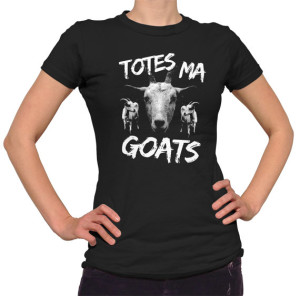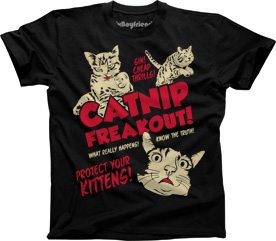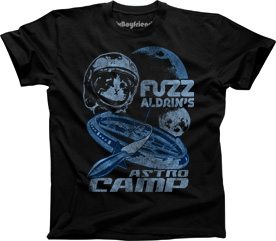This interview is with Matt Snow and Meredith Erin who run Ex-Boyfriend and and BoredWalk
Matt Snow, Chief Creative Officer: Head designer, responsible for execution of roughly 95% of the creative content across brands (Ex-Boyfriend and BoredWalk), from apparel design to web design and most things in between (branded collateral and other assorted marketing materials, product photography, etc.) Matt is also the expert on production, with several years of experience working in commercial print shops before starting our own.
Meredith Erin, Chief Operations Officer: The brains of the operation. Meredith does most of the content ideation. Meredith also acts as the de facto Art Director, providing critical feedback on designs and other content, taking them from the drawing board to print-ready designs. She is also responsible for logistical duties, such as accounts payable/receivable, sourcing raw goods and production materials, and managing vendors.
Ex-Boyfriend is about creating fun, unique, original wearable art that, in the right hands (or on the right body) becomes an instant conversation starter, whether you’re on the bus, in class, in the bar, on the sidewalk, or at the park.
BoredWalk is mostly making money. But also providing a test-lab for designs, seeing what works, seeing what doesn’t, and figuring out how to design in a certain style or aesthetic that doesn’t really “fit” the niche that Ex-Boyfriend inhabits.
What sets your company apart from others?
Well, with Ex-Boyfriend, originality. The bulk of our product line with the Ex-Boyfriend brand is made up of wholly original characters and concepts. The few that aren’t feature public domain characters, but with a unique, fun, and slightly irreverent twist.
 With BoredWalk, it’s more about variety. We’re very trend-conscious about what we do with BoredWalk, doing a ton of market research, both online and in brick & mortars, paying obsessive attention to design trends like typography, composition, color palettes. We would never rip someone off, but if we notice a trend, we dissect it, reduce it to its base components, and then try to create the best possible representation of said trend.
With BoredWalk, it’s more about variety. We’re very trend-conscious about what we do with BoredWalk, doing a ton of market research, both online and in brick & mortars, paying obsessive attention to design trends like typography, composition, color palettes. We would never rip someone off, but if we notice a trend, we dissect it, reduce it to its base components, and then try to create the best possible representation of said trend.
The big through-line for both brands is quality, both in terms of design and the finished product. We don’t retail at big box store price points — our stuff is affordable, but we believe in making a living for ourselves, paying our employees considerably more than minimum wage, offering paid time off, etc. That all comes at a price; specifically, the prices we retail our stuff at. But our end of the deal is to make sure that our customers get their money’s worth. We print on nice, soft, combed ringspun blanks, use water-based inks, and are really rigorous with our quality-control standards to make sure that what we ship to our customers is of the quality we’d expect for our own wardrobes. Unsurprisingly, we wear a lot of our own merchandise.
What were your biggest mistakes running a clothing company? How would you of done things differently with the experience you have now?
Not moving to SoCal earlier, and outsourcing so much of our production in the early days. Also, paying outsiders to do P.R. & marketing. We learned really early on not to hire anyone to do something for us that we don’t know how to do ourselves; it makes us incapable of making good hiring choices and managing those hires. Obviously there are exceptions for things like lawyers or accountants, but generally speaking we educate ourselves on every aspect of our business before considering paying anyone to help us.
If we had to do it over, I think we’d have become students of the casual fashion industry and trend-spotting from the get-go (rather than just creating in a bubble and expecting customers to just find us and love us immediately), make more of an effort to really understand the various production methods and their respective advantages and drawbacks, and brought the bulk of our production in-house sooner.
We also wasted time & money early on by retaining P.R. agencies to pitch our stuff to various media outlets. We got more media hits by pitching to outlets directly on our own than any agency ever did, because most of those types of agencies will just try and take what worked for a few of their more successful clients and apply it to their whole client roster. Tone-deaf, irrelevant email blasts from a faceless agency intern don’t get nearly as much traction as an email addressing the recipient by name and pitching products that are actually relevant to their readers/subscribers.
Being in southern California kind of touches on all of that stuff. You can definitely start a brand anywhere (we started in Baltimore), but it’s tough to really grow it to the point of profitability when you don’t own the means of production yourself and have access to a limited pool of suppliers & vendors. Investing in our own heat presses and DTG printers dramatically reduced our operating costs while also improving our quality control. Being in the LA area was also essential because we are within an hour or less of every type of supplier we need, from inks to blank clothing to shipping supplies. We are even close to the garment district, making cut and sew projects a much easier proposition.
 What is your most memorable moment running your clothing company?
What is your most memorable moment running your clothing company?
Probably the first time we had a truly successful retail show where we recouped the booth fee AND made a decent amount of money beyond that. Pretty sure it was the Art Star Craft Bazaar in Philadelphia in 2010 or 2011. We’d done a couple of shows prior to that (including Art Star once before a few years earlier), but were still figuring out what our brand was about in those days. That second Art Star appearance was the first show we did after making a conscious decision to try and elevate our brand awareness via the show circuit.
Anyway, even with truly abysmal weather for most of the weekend, our product line seemed to really resonate with the crowd. I think that was the first time we had an inkling that maybe this could grow from a hobby into something more.
What was your breakthrough moment?
Ha! That’s tough to pinpoint — in some ways we’re still waiting for it — but I guess there are four moments that really stick out:
1. Growing the first brand to the point where I had to tell Meredith that to grow the business any further, I’d either have to hire an employee, or she’d have to quit her day job and join me full-time.
2. Moving to LA for the business.
3. Moving the business out of the house/garage and into its own commercial space.
4. Hiring our first full-time employee.
What is the best form of advertising you use and how has your advertising changed since you started?
Well, the nice thing about selling graphic tees is that every time you sell one you’re turning that customer into a walking billboard for your art and/or brand. When we started we did mess around with AdRoll & AdWords a bit — and something else called Project Wonderful — but I think the thing that’s had the biggest impact over the life of our business is our email list, which we’ve built up over the years mostly via sign-up’s at shows. It’s very targeted because people are signing up of their own volition, and are doing so because they’re legitimately interested in our brand and our designs. We also make a point to assure them that at most they’ll only receive one email a month from us.
At this point it’s pretty much just the odd show, email blast, and/or word of mouth. We haven’t paid for advertising in about four years.
What do you know now that you wish you knew when you started?
That’s tough, because pretty much everything that’s coming to mind is stuff that can only be acquired through experience, both on the creative AND business side. I guess we wish we’d started BoredWalk sooner. It helps pay the bills in a way that Ex-Boyfriend was never able to on its own due to its smaller, niche appeal. But we never felt comfortable doing something solely for the money until we were in LA — it’s really frowned upon in the indie community everywhere else, but in LA it’s very common for creative professionals to do something less-than-fulfilling to pay their rent/mortgage/whatever as a day job, and then have a creative business on the side or in conjunction with their day job that showcases their true passion & talent. It was refreshing to move someplace where the Integrity Police aren’t sniffing around just looking for a reason to point and scream “sellout!” every time we put a beard or a mermaid on a t-shirt just because those are popular at the moment.
Taxes, legalities, business, what is some advice you would give others starting out?
Haha, um…don’t start a business? OK, maybe not quite that, but…don’t be too romantic about it. Regardless of whether you’re selling t-shirts or gaskets, starting a business and making it successful is fucking hard. We work 50-60 hours/week during our slow months. From mid-November through December 23rd, that jumps to 80-100 hours/week. It used to be worse, but it’s still a lot of work. Here’s a short bulleted list of advice:
• Make a schedule. Stick to it. It’s still a job.
• It’s not your family or your friends’ responsibility to support your dream unless it’s also their dream. They’re cheerleaders, not loan officers.
• Pay your taxes in full and on time. That said, make sure you’re not paying taxes unnecessarily. For example, in Pennsylvania, you don’t need to collect sales tax on clothing because it’s classified as a “necessity” in their state tax code. In New York, I think it’s just clothing over a certain dollar amount (I vaguely remember it being applicable for items retailing over $110.)
• Do EVERYTHING over email. Have a paper trail. If you’re dealing with people who are all about talking on the phone, immediately recap the call in an email and send it to them requesting a confirmation that yes, that IS what was agreed to on the call. Typically people who prefer to conduct business over the phone are doing so precisely because they don’t want a record of what was said/promised/agreed to.
• Do you want to make money or art? It’s an important distinction because they do not necessarily go together. There’s a very different mentality between using your creative abilities to make money and using them just for a creative outlet. If money is your priority, you have to be willing to put personal taste aside and focus on what’s profitable. It’s not about what you want to sell, it’s about what people want to buy.
What advice would you give someone that is starting a clothing company?
• Again, it’s crazy-hard. It’s a very saturated space (not as bad as jewelry, but close). Setting your brand apart is very difficult, and you can’t count on your creative vision being on-trend all the time — allow for some creative evolution.
• Don’t rip people off. Don’t use other peoples’ IP. Learn what the legal definitions of satire and parody are — dressing up Hello Kitty like Princess Leia is neither, and if you do it without paying San Rio AND Disney the licensing fees, I hope you get sued so hard your great-great-grandkids feel it. There’s plenty of money in the public domain and in original ideas. Don’t be lazy. If you can’t come up with your own ideas that don’t depend on other people’s trademarks you have no business in this space.
• Celebrity gift lounges are typically a waste of money.
• If a blogger hits you up for free merch to “review”, they’re just looking for free shit. Avoid.
• Subscribe to the Willy Wonka business model when it comes to growth; don’t hire established experts — they’ll just want to do things their way, even if it makes no sense for your brand. Learn that shit yourself, then hire an aimless (but ambitious and loyal) young person looking for direction and train them yourself. And pay them a living-fucking-wage!
• Never lose sight of the importance of company culture. Read (or listen to) Delivering Happiness by Tony Hsieh (CEO of Zappos.com). Not many business books are worth the paper they’re printed on. That one is.
Where do you do the majority of your business, online, trade shows, craft shows, stores?
Right now, online. A couple years ago our split was pretty even between online, retail shows (craft fairs & comic cons, mostly), and wholesale, but now it’s mostly online retail. We plan to start doing trade shows in Vegas again this year, but first we’re launching two new lines and doing some more hiring, so we have a few things to cross off the to-do list first.
What changes do you see in the future with your company, the t-shirt industry, and the internet?
For us? Further diversification — adding new brands, new product types, etc.
For the industry? I expect DTG will continue to improve in quality and price (it already has by leaps and bounds since it first popped up 10-15 years ago), and I wouldn’t be surprised if 3D-printing tech advances enough in the near-ish future to allow for organic materials. That’ll disrupt stuff a bit.
What keeps you passionate and motivated about your clothing company?
At the most basic level? Paying our bills. But there’s always a new challenge — learning a new design style or trick, launching a new brand with a different kind of demographic in mind and figuring out how to best reach and sell to them, and, sometimes, the satisfaction of looking at a just-completed design and being impressed with it. It doesn’t happen a lot, but when it does, it’s a pretty rad feeling.
 What has worked best for you in social media?
What has worked best for you in social media?
Mostly pictures of our cats and our food. That’s all anyone on the internet really cares about, right?
Links




